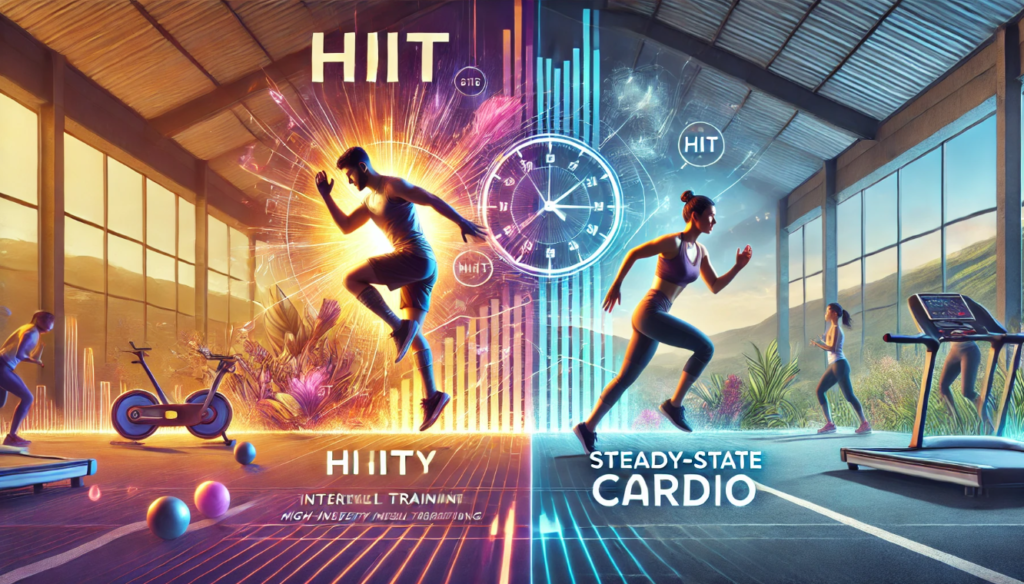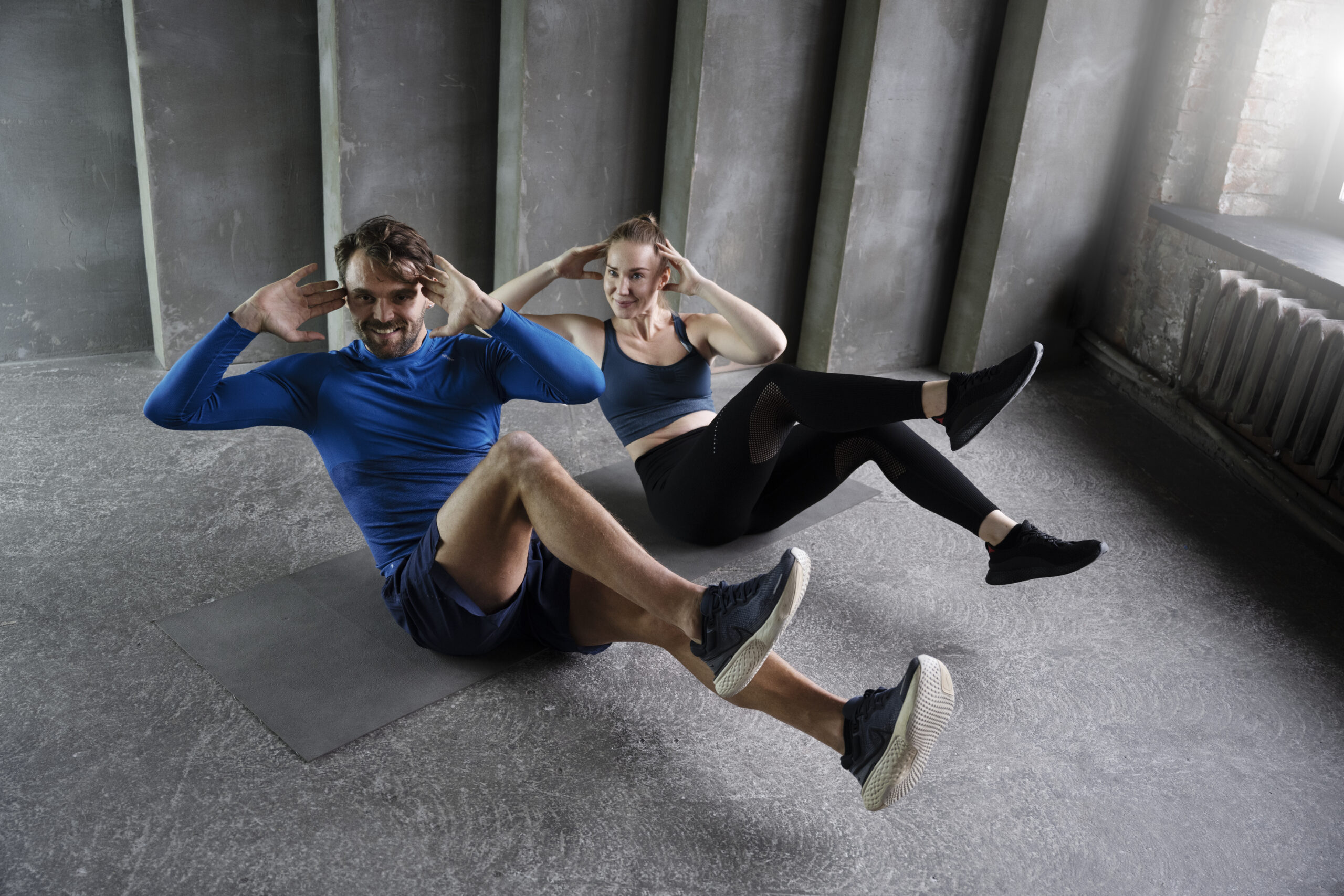When it comes to cardio workouts, there’s a debate that has stood the test of time: HIIT vs. Steady-State Cardio: Which is better? Both methods offer unique benefits, and the best choice often depends on your fitness goals, lifestyle, and preferences. This article delves into the pros and cons of both HIIT and steady-state cardio, focusing on their effectiveness for fat loss, heart health, endurance, and more.
Understanding HIIT and Steady-State Cardio
High-Intensity Interval Training (HIIT):
HIIT alternates between short bursts of intense activity and periods of rest or lower-intensity movement. For example, sprinting for 30 seconds followed by walking for 1 minute, repeated multiple times. It’s a time-efficient way to maximize calorie burn and improve fitness levels.
Steady-State Cardio:
Steady-state cardio involves maintaining a consistent intensity level over an extended period. Activities like jogging, cycling, or swimming at a moderate pace are classic examples. This method is straightforward and suitable for individuals of all fitness levels.
HIIT vs. Steady-State Cardio for Fat Loss
Both HIIT and steady-state cardio can help with fat loss, but the mechanisms differ.
| Aspect | HIIT | Steady-State Cardio |
|---|---|---|
| Calorie Burn | Burns more calories in a shorter time. | Burns calories steadily over a longer period. |
| Afterburn Effect | Induces EPOC (Excess Post-Exercise Oxygen Consumption), continuing calorie burn after the workout. | Minimal afterburn effect. |
| Time Commitment | Ideal for those with limited time. | Requires a longer time commitment. |
Research suggests that HIIT may be more effective for targeting belly fat due to the intense bursts of effort. Users on platforms like Reddit often debate hiit vs steady-state for fat loss, but the consensus leans toward HIIT for its efficiency and metabolic benefits.
HIIT vs. Steady-State for Heart Health
Both forms of cardio benefit cardiovascular health but impact it differently:
- HIIT: Improves both aerobic and anaerobic fitness by challenging your heart rate with intervals. It’s especially beneficial for those aiming to boost heart efficiency in a short time.
- Steady-State Cardio: Encourages a stable heart rate, which is excellent for building endurance and overall heart health over time.
For individuals with heart conditions or those new to exercise, steady-state cardio examples like brisk walking or cycling are gentler on the heart.
HIIT vs. Steady-State Cardio for Endurance
Endurance is crucial for athletes and fitness enthusiasts, and each method contributes differently:
- HIIT: Enhances anaerobic endurance, making it suitable for sports requiring short bursts of intense activity.
- Steady-State Cardio: Builds aerobic endurance, which is ideal for marathon runners and cyclists.
The choice between hiit vs steady-state cardio for endurance often depends on whether you need short-term stamina or long-term resilience.
Time Efficiency and Convenience
HIIT shines in time efficiency. A 20-minute HIIT workout can offer comparable results to a 45-minute steady-state session. However, steady-state cardio is more forgiving and sustainable for beginners or those recovering from injuries.
Steady-State Cardio Examples
If you’re new to steady-state cardio, consider these activities:
- Jogging at a moderate pace for 30-60 minutes.
- Cycling on flat terrain at a steady speed.
- Swimming laps consistently for an extended period.
- Walking briskly for an hour.
These are great options for those seeking low-impact, steady-intensity workouts.
HIIT vs. Cardio: Which is Better for Belly Fat?
When tackling belly fat, many wonder, “Is HIIT or running better for belly fat?” Studies indicate that HIIT’s high intensity promotes greater fat oxidation and metabolic effects, making it slightly more effective than steady-state cardio for belly fat reduction.

Comparing HIIT and Steady-State Cardio for Weight Management
| Factor | HIIT | Steady-State Cardio |
|---|---|---|
| Weight Loss Effectiveness | Effective for short-term fat loss due to high intensity. | Sustainable for long-term weight management. |
| Muscle Retention | Helps preserve lean muscle mass. | May lead to muscle loss if overdone. |
| Energy Requirements | Demanding but time-efficient. | Requires consistency over a longer period. |
When deciding between hiit vs steady state cardio which is better for weight or fat, the answer depends on your specific goals and physical capacity.
Safety Considerations
- HIIT: Not recommended for beginners or individuals with joint problems due to its high impact.
- Steady-State Cardio: Safer for all fitness levels but requires more time to achieve similar results.
FAQs
- What is the best option for fat loss?
For quick fat loss, HIIT may be more effective due to its afterburn effect. - Which is better for heart health?
Both are beneficial. Steady-state cardio offers sustained heart health benefits, while HIIT improves heart efficiency. - Can beginners try HIIT?
Beginners should start with steady-state cardio and gradually incorporate HIIT once they build a base level of fitness. - Is HIIT better than running for belly fat?
HIIT is more efficient for targeting belly fat due to its intensity. - What are some steady-state cardio examples?
Walking, jogging, cycling, and swimming are common examples. - How often should I do HIIT vs. steady-state cardio?
HIIT: 2-3 times per week. Steady-state cardio: 4-5 times per week for optimal results.
Conclusion
Ultimately, the choice between HIIT and steady-state cardio depends on your goals, fitness level, and time availability. Both have distinct advantages, whether you’re aiming for fat loss, endurance, or heart health. The key is consistency. Whichever method you choose, make sure it aligns with your lifestyle and preferences for the best results.
Whether it’s hiit vs steady-state for fat loss or hiit vs cardio for overall fitness, incorporating both types into your routine can help you achieve a balanced and effective workout plan.


